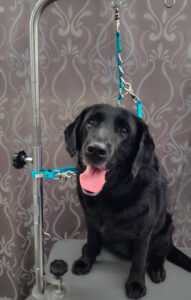
The Fearful Dog—Part 1
May 17, 2017
Why are some dogs social butterflies and others afraid of their own shadows? Why do some dogs get excited when they see a new person and others shake and hide behind their owners? Dogs can become fearful for a variety of reasons. Some are genetically predisposed to be shy or fearful. Others are under socialized. The critical socialization period for a puppy is between four and sixteen weeks of age. This is the time that puppies will accept the things that a dog is likely to encounter in life: people, places, others animals, noises, etc. Many times, vets will advise puppy owners not to take their puppy out until fully vaccinated which is at about four months of age. The problem is that by the age of four months the puppy is outside the critical socialization period. There is a much greater chance that puppies will become fearful, which could lead to aggression, rather than catch a virus or disease if taken outside the home. Another reason that a dog may become fearful is that they’ve had a traumatic experience. Dogs make associations very quickly, which is why people should try to make their puppy’s experiences positive and fun. For many dogs the reason for their fear is unknown.
Fearful dogs are brought to me quite often. People just want to “fix” the problem. There is no quick easy fix to rehabilitating a fearful dog. Building confidence and trust in a dog is complicated. For example, if you had a fear of elevators, would you overcome that fear if I forced you inside an elevator? No… in fact it may make your fear worse. Rehabilitation programs to overcome fear take time and patience.
How do we identify a dog that is fearful? Dogs are very good at communicating. The problem is that they don’t speak the same language as we do. Dogs are not verbal. One of the biggest mistakes that people make when they work with their dog is that they are too verbal. Yes, we can teach dogs words by saying the word when the behavior happens and repeating this process. Dogs use their body language to communicate whether it’s to another dog or to humans. So how do dogs use their body language to tell us that they are fearful? A fearful dog might hold his body down close to the ground. His tail may be down and even tucked in between his rear legs. He may have his ears back and flattened down. The hair on his back may be standing upright. You may hear growls or other vocalizations. A fearful dog most likely will not take food or treats when they otherwise would. The dog may hide behind its owner or seek a safe location away from what’s triggering his fear. The dog may appear to be nervous: pacing, jumping on the owner or exit door, scratching or licking himself, yawning, panting, etc. It’s important that you learn what your dog is trying to communicate to you by understanding his body language.
It can be very challenging to work with a fearful dog. It’s hard sometimes to understand why the dog just doesn’t trust you. It takes time to build a bond and relationship with your dog. Many dogs can overcome their fears through a desensitization and counterconditioning program. Basically what this program does is to change the dogs’ response to whatever is triggering their fear from a negative to a positive one.
Next time: Helping to reduce your dog’s fear.


